The Shawnee National Forest in southern Illinois is a mosaic of towering trees, lush wetlands and commanding rock formations that are the native habitat for a wealth of plants and animals, including 19 species of oaks.
The Shawnee National Forest in southern Illinois is a mosaic of towering trees, lush wetlands and commanding rock formations that are the native habitat for a wealth of plants and animals, including 19 species of oaks.
The forest is also a microcosm of an emergent national debate about how North America should manage public lands as wildfires burn through Canada, Hawaii and Louisiana. Climate change is catalyzing extreme weather events and drying ecosystems, making forests increasingly vulnerable.
„It’s impossible to take our hands all the way off. We’ve caused this climate change. We’ve introduced invasive species. We’ve put out historic wildfires. We’ve carved up the forest with roads. So, our influence on our forests is inescapable now,“ said Chris Evans, a forest research specialist at University of Illinois at Urbana-Champaign.
But the U.S. Forest Service and environmentalists have opposing philosophies about how to tend to the Shawnee and other forests in the face of the climate crisis.
The Forest Service wants to take a more active role in encouraging woodland health and mitigating wildfire risk while many environmentalists want to create preserves where nature can heal itself.
The federal agency’s primary goal is to regenerate native ecosystems and increase biodiversity lost to poor farming practices and fire suppression dating back to the mid-19th century.
„If we don’t actively reintroduce disturbances using tools such as fire and timber harvest in this ecosystem, we will lose a community that is disproportionately important for wildlife,“ said Michael Chaveas, forest supervisor of the Shawnee and the Hoosier National Forest in Indiana.
To encourage new tree growth, the Forest Service has invited timber companies to log parcels of both forests, a practice environmentalists in Illinois have encountered before.
In 1990, John Wallace left his career as a public land manager in Carbondale and dedicated his life to stopping commercial activity in the Shawnee. As part of a 79-day occupation of a logging site, he tethered himself to a log skidder with a bike lock. Authorities had to forcefully remove him with a blowtorch and arrested him. His protests eventually helped lead to a 17-year injunction on logging that was lifted in 2013.
Today, Wallace once again sees timber lorries driving into Illinois‘ only national forest, and he has revived the fight to keep them out, this time with climate change front and center.
The mature oaks in the 289,000-acre forest must be left alone so they can optimally sequester carbon and the forest can naturally heal from human disturbances, according to Wallace and his allies at the Shawnee Park and Climate Alliance.
These environmentalists are campaigning to transfer oversight of the Shawnee from the Forest Service to the National Park Service, whose mission to preserve natural ecosystems puts a near-total ban on for-profit resource extraction.
Under the proposal, popular destinations such as Garden of the Gods would become a national park with the strictest land use regulations. The rest of the Shawnee would become the nation’s first preserve created to mitigate climate change. Public hunting, backcountry camping and other noncommercial recreational uses would be permitted, but trees would be left intact.
„Climate change is happening fast and we need to take drastic action. … We need to really protect and encourage natural ecosystems for their ability to sequester and store carbon,“ Wallace said.
Healthy forests offset greenhouse gases, which are the main driver of climate change, by absorbing more carbon than they release. All U.S. forests combined absorb more than 10% of annual domestic greenhouse gas emissions, according to the Biden administration.
However, whether forests are carbon sinks or emit carbon depends on how they are managed. Large, mature trees sequester the most carbon, trees release carbon when they are cut down and fires emit carbon.
The Alliance, which is supported by the cities of Carbondale and Murphysboro and the Illinois Audubon Society, is part of a growing movement to leave forests alone.
In Indiana, local opposition has mounted against Forest Service plans to ramp up logging and prescribed burning in the Hoosier forest. Last month in Oregon, a federal judge found a Trump-era rule change allowing large trees in the Pacific Northwest to be harvested violates several laws. And, a week ago, a coalition of 28 environmental groups sent the Forest Service a letter opposing a logging project in Wisconsin’s Chequamegon-Nicolet National Forest, citing concerns that it does not align with the Biden administration’s latest environmental recommendations.
The Biden administration has recognized mature and old-growth forests as „critical carbon sinks.“ In April, the Forest Service and the Bureau of Land Management created an initial inventory of these forests, following an executive order to protect them from climate change threats and enhance carbon sequestration.
The Alliance’s campaign builds on this movement by pushing to establish the first national preserve explicitly intended to safeguard mature trees to tap into their carbon sequestration potential. First, Congress would have to pass legislation to transfer the forest to the Park Service.
However, there is no consensus about how much primacy should be given to protect mature trees.
Forests are complex ecosystems and a sole focus on preserving older trees to optimize carbon sequestration is shortsighted, according to Eric Holzmueller, a forestry professor at Southern Illinois University. Trees are simultaneously dying and growing at different rates, and these rates change over time, making it difficult to project sequestration levels.
„It is a challenging puzzle in that there’s not a real clear answer. (Carbon sequestration) can be complicated and no one has really looked at the details of how the proposed management actions would either help the forest accumulate carbon or not,“ he said.






